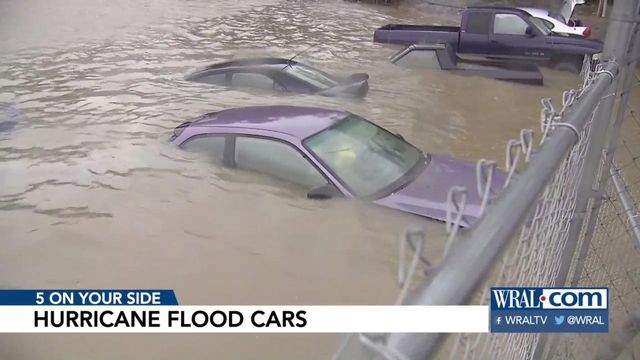Consumers beware: Flooded-out cars may wash up on used car lots
A wave of water-logged vehicles could soon wash up on some used car lots after powerful hurricanes soaked Texas and Florida earlier this year.
Posted — UpdatedIn many instances, buyers can get stuck with the flooded vehicles because they are cleaned up to a point where shoppers cannot tell the cars were ever damaged. Since the timing is right for vehicles flooded in Harvey and Irma to move from those states to be sold, buyers should be on alert, consumer experts say.
Immediately after a storm, flood damage to vehicles is easy to distinguish because of the mold, mildew, mud and a bad smell that generally permeates the automobile.
"If you strip it down, take the seats out (and) clean the carpets, that smell goes away for a little bit (and) the car looks good" on the inside, said Chris Basso of CarFax.
In North Carolina and most other states, it is illegal to sell a flooded vehicle without disclosing the damage to the buyer, but that crime still happens.
"Too often, when an insurance company declares a flood-damaged car a total loss, that information isn't clearly communicated to potential buyers," said Jon Linkov, an auto editor for Consumer Reports.
Consumers should thoroughly check out a used vehicle before buying it.
Linkov has some tips to avoid buying a vehicle that has been damaged during a flood.
"The first thing you want to do is come over to the front of the car (and) inhale and see if there's any kind of moldy or musty smell," he said. "If you have that, you definitely want to walk away from the car."
Linkov also advised potential buyers to walk away if they inspect the trim panel on the side of the door and find dirty carpet or see any sediment or rust inside the vehicle.
Linkov said buyers should inspect the door pockets.
"If there's any kind of sediment in there or dirt or stones when the water came into the car, as it drained away, it settled and hid in there," he said.
Consumers should also:
- Pop off some of the caps and covers for the seat bolts. If those are scratched or look rusted, that means the seat was taken out so it could air dry, experts said.
- Look where a spare tire would be kept. If the vehicle has sound deadening, the consumer should smell to see if it's musty or moldy. The potential buyer should also see if there is any rust on any exposed screws, panels, or even on the tools, like the jack or the jack stand.
- Inspect the rear of the engine bay to see if there is some soft material there. When the water that got into the car recedes, it will leave a flood line. "If there's anything like that, walk away from the vehicle," Linkov said.
According to Consumer Reports, vehicle history reports are no guarantee that a car won't have problems. And consumers should pay an independent mechanic to inspect the vehicle before it's purchased. The cost is usually $100 or less.
• Credits
Copyright 2024 by Capitol Broadcasting Company. All rights reserved. This material may not be published, broadcast, rewritten or redistributed.





